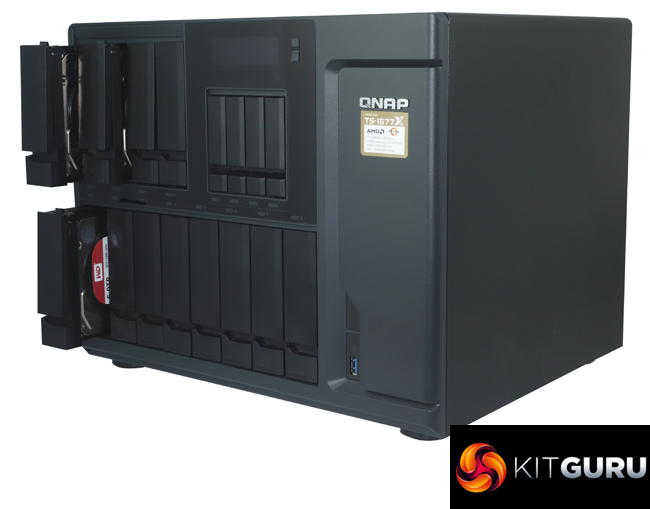QNAP is producing some seriously well featured NAS units of late and the TS-1677X continues this trend. Not only do you get sixteen external drive bays, there’s also an AMD Ryzen 7 1700 CPU, 16GB of DDR4 memory (expandable to 64GB), dual 10GbE NICs, two PCIe Gen.3 slots (one x8 the other x4), one PCIe Gen.2 x4 slot and last but by no means least, four Gigabit Ethernet ports.
The three PCIe ports give the TS-1677X a good deal of expandability and a good degree of future proofing. They support 10/40 GbE networking adapters, PCIe NVMe SSD and USB 3.1 expansion cards. The x8 PCIe slot even supports dedicated graphics cards, with a full compatibility list on QNAP’s website. To this end the TS-1677X is powered by a 550W PSU. One word of caution though, you will need to take care choosing cards for the pair of x4 slots as there is only around 156mm of clearance because of the proximity of the CPU cooling shroud.
Any NAS is only as good as its operating software and the TS-1677X uses one of the best ones around, QNAP’s QTS. It’s a quick and easy to install OS with a graphically rich interface which is useful for first time users to navigate around the software – but for the more advanced users, delving beneath the surface reveals a whole host of features including a couple of important ones for data heavy environments; network traffic distribution and tiered storage.
As the TS-1677X has two 10GbE and four 1GbE NICs (plus any additional add-in cards) it can be set up so applications can use dedicated NICs to help alleviate any network traffic distribution problems. Setting up and managing these network connections can be done via the Network & Virtual Switch app which can be downloaded from the QTS App Center.
Using QNAP’s powerful Qtier technology you can set up SSD caching and auto-tiering, so storage can be optimised according to how it’s being stored and used. Qtier 2.0 analyses I/O read and writes of any storage pools to determine the best course of action; the most active “hot” data is moved to faster performing drives, while the less active “cold” data is migrated to slower but higher capacity drives.
Should you start to run out of storage space with the base unit, worry not as the TS-1677X supports a range of QNAP's expansion enclosures. The UX-500P (5-bay) and the UX-800P (8-bay) units feature hot-swappable bays and connect to the TS-1677X via one of the rear USB 3.0 ports. The TR-004 is a 4-bay unit which connects via a USB 3.0 Type-C port. Finally there is the REXP-1000 PRO. Things get a little more complicated with the 10-bay REXP-1000 Pro as it uses a SAS interface so you will need a 12 Gb/s SAS expansion card in the TS-1677X to be able to connect to it.
We found QNAP's TS-1677X-16G on Span.com for £2,791.20 HERE
Pros
- AMD Ryzen CPU.
- Huge storage capacity.
- Impressive list of hardware features.
- Integrated dual 10GbE
- QTS software.
- Expandability.
Cons
- Need to take note of the space restriction for the two x4 PCIe slots.
- No M.2 SSD slots on motherboard.
KitGuru says: QNAP keeps producing stunning NAS units for business and the TS-1677X is no exception. It offers huge capacity support, plenty of future proofing and integrated dual 10GbE for faster networking.
 KitGuru KitGuru.net – Tech News | Hardware News | Hardware Reviews | IOS | Mobile | Gaming | Graphics Cards
KitGuru KitGuru.net – Tech News | Hardware News | Hardware Reviews | IOS | Mobile | Gaming | Graphics Cards




